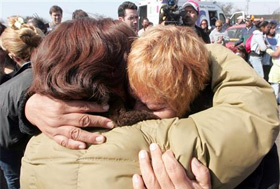 |
 |
 |
 News Around the Republic of Mexico | February 2006 News Around the Republic of Mexico | February 2006  
Trapped Mexico Miners' Families Cling to Faint Hope
 Catherine Bremer - Reuters Catherine Bremer - Reuters


| | Relatives hug and weep as they wait for news from rescuers trying to reach trapped miners in San Juan de Sabinas, northern Mexico, February 20, 2006. (Reuters/Henry Romero) |
San Juan de Sabinas, Mexico () - Shivering against the cold, relatives of 65 Mexican miners trapped in deep coal shafts for more than two days clung to threads of hope on Tuesday the men could be found alive despite painfully slow rescue efforts.

A gas explosion deep in the mine in the northern state of Coahuila on Sunday collapsed hundreds of yards of tunnel and trapped almost all the miners working a night shift.

Rescuers working only with hand tools for fear of sparking a new explosion reached within 55 yards of where two of the men had been working on a conveyor belt at the time of the blast.

But a volatile mix of gases and two new rockfalls hampered efforts to get to them.

No contact has been made with any of the men, who carried oxygen tanks with only six hours of air in them.

Bundled in sweaters and blankets, 30-year-old Maria Teresa Rodriguez sat pressed against a gate guarding the Pasta de Conchos mine, awaiting news.

"I'm staying here until my husband comes out," she said, clutching a steaming cup of coffee handed out by a volunteer.

"There is always danger in the mines, all the wives know that. But I have faith in the rescuers and I believe they will pull somebody out soon."

At the mine entrance, Labor Minister Francisco Salazar said teams of rescue workers were going slowly but expected to reach the first group within the next hours.

The rest of the men were thought to be in groups up to 1 1/4 miles into the mine, near the town of San Juan de Sabinas, 60 miles southwest of Eagle Pass, Texas.

"There is no way to make contact with them," Salazar said. "We will have to advance another 800-900 meters (900-1,000 yards) to find the next post where men were stationed," he said.

MOVING SLOWLY

Mine operators say air pockets might still keep the men alive.

A group of specialist rescuers from West Virginia and Washington states were due to arrive later in the day at the mine, owned by Grupo Mexico.

Around 60 rescue workers, mainly local miners using picks and shovels, worked in shifts to remove tons of rock and metal beams crushed by the explosion.

Miner Doroteo Hernandez Corona, who emerged from the mine covered from head to toe in coal dust after a six-hour shift, said progress was very slow.

"(It takes) 2-3 hours to advance a meter. We have to move very carefully," he told reporters.

But rescue teams have so far been unable to widen an air ventilation shaft enough to send rescuers and their equipment into the collapsed chambers where the bulk of the miners were trapped. There was a high risk that more of the mine would give way.

Volunteers gave out coffee and cooked breakfast for dozens of relatives huddled around bonfires in the chilly dawn light.

Some built a makeshift shrine, lighting candles in front of an image of the Virgin Mary and praying that the miners be found alive.

Miners at Pasta de Conchos earn around 600 pesos ($57) a week. The arid region around the mine is poor and dotted with small shacks.

Grupo Mexico denied workers' claims the company had been negligent about safety.

Several workers and the National Mineworkers' Union leader Napoleon Gomez said their was evidence of lax safety standards in the mine, with infrequent monitoring of gas levels and loose cables in the shafts. | 
 | |
 |



